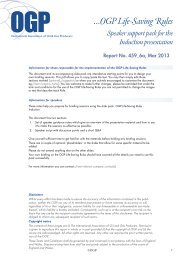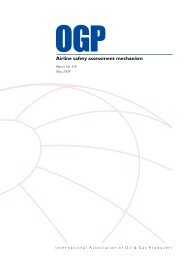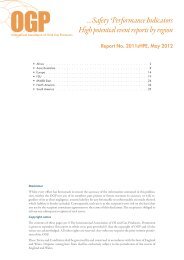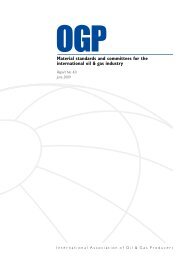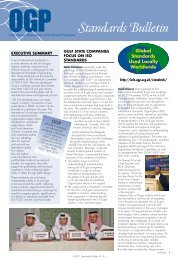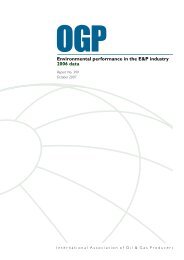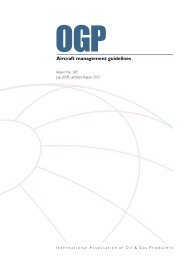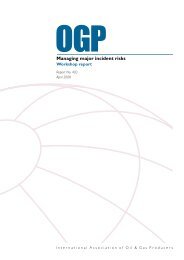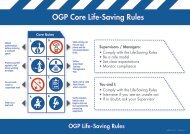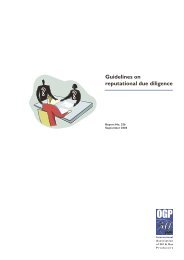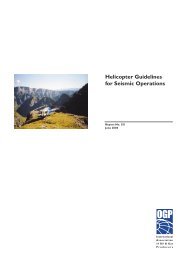Helicopter guidelines for land seismic & helirig operations - OGP
Helicopter guidelines for land seismic & helirig operations - OGP
Helicopter guidelines for land seismic & helirig operations - OGP
You also want an ePaper? Increase the reach of your titles
YUMPU automatically turns print PDFs into web optimized ePapers that Google loves.
International Association of Oil & Gas Producers<br />
D.7.2<br />
15. All helicopter fuel nozzles will be equipped with dust caps and bonding clips<br />
or jacks. The nozzle should be kept off the ground and facing downward to<br />
preclude water contamination with a drip tray below it.<br />
16. Suspend fuel <strong>operations</strong> immediately when a lightning discharge hazard exists.<br />
In addition to the points listed above, the following should apply to refueling from<br />
drums or small transportable bladders:<br />
1. Each drum of fuel should be sampled and tested with water detector capsules<br />
or an approved paste to confirm no water contamination is present and visually<br />
inspected <strong>for</strong> proper color, transparency and contamination.<br />
2. Pumps used <strong>for</strong> drum refueling should be equipped with water blocking<br />
filtration system.<br />
3. Pump standpipes should extend no closer than 50 mm (2 inches) of the drum or<br />
bladder bottom.<br />
4. Be<strong>for</strong>e fueling the aircraft, a small amount of fuel should be pumped into a<br />
container to remove any contaminants from the hose and nozzle.<br />
5. Wherever possible, drums and small bladders should be left to settle <strong>for</strong> 3 hours<br />
after transport or moving them to the refueling location, be<strong>for</strong>e use.<br />
6. The drum or bladder should be positioned as far as possible from the aircraft.<br />
D.8 Bonding and grounding<br />
D.8.1 To minimize the fire hazard from static or stray electricity on the helicopter or<br />
fuelling equipment, all equipment will be properly grounded to earth be<strong>for</strong>e fuelling<br />
<strong>operations</strong> or the transferring of fuel from one storage tank to another.<br />
1. All bonding and grounding cables should provide an easy path <strong>for</strong> the electricity<br />
to flow to the earth through a conductive lead, such as braided copper cable.<br />
2. All grounding rods will be driven into the earth at least several centimeters (this<br />
applies to winter <strong>operations</strong> as well when possible) otherwise bonding will be<br />
conducted.<br />
3. Cables, clips and plugs used <strong>for</strong> bonding and grounding will be inspected and<br />
tested <strong>for</strong> continuity checks should be done annually or after relocation of base<br />
camp.<br />
4. Resistance through any bonding or grounding circuit should be less then 10<br />
ohm.<br />
5. All connection points and grounding plugs should be clean and unpainted.<br />
6. If the helicopter is without a bonding jack, attach the bonding clip at the end of<br />
the nozzle bond wire to the tank filter cap be<strong>for</strong>e the tank filler cap is opened<br />
to ensure that there is no difference in potential between the two elements.<br />
Maintain this contact until the flow of fuel has stopped and the filler cap<br />
replaced.<br />
D.8.2 When fuelling from drums, the following precautions will be taken:<br />
1. Ground the drum to a grounding rod.<br />
2. Ground the helicopter to the same grounding rod.<br />
3. Bond the drum or tank and nozzle to the helicopter be<strong>for</strong>e opening the filler<br />
cap<br />
4. Disconnection should be in the reverse order, upon completion of fuelling.<br />
58<br />
© <strong>OGP</strong>



